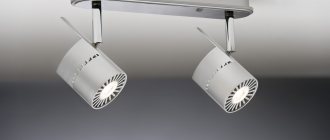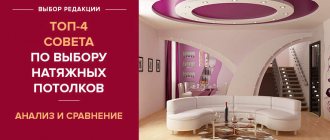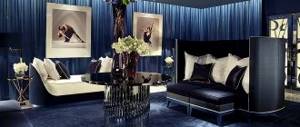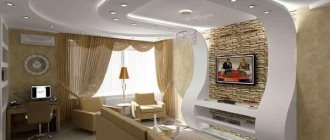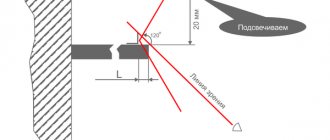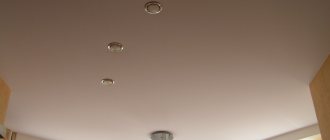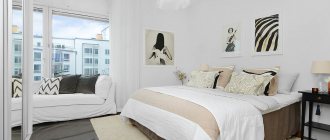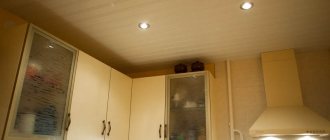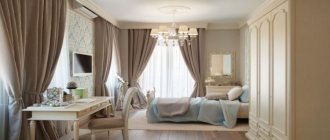Features of spots
Spots are autonomous lighting devices that are suitable for installation on the surface of the ceiling and walls. The design of products of this type consists of a base, an articulated bracket and a lamp. The main specificity of the spots is the presence of a movable bracket: this makes it possible to change the direction of the light depending on the need. Products of this type got their name from the English “spot” - which means “spot, dot”. Indeed, lamps emit concentrated rather than diffused light, allowing them to highlight certain directions or objects.
Along with movable brackets, the design of devices sometimes contains built-in dimmers: we are talking about power and brightness controls. Thanks to this, it becomes possible to save electrical energy by supplying it in the volumes required for a given time of day or needs. For example, during reading or homework, the beam power can be increased, and at other times it can be decreased.
Types and features of spots
Spot translated from English means “spot”. They are available in different sizes and types, but the components are identical:
- Base. It includes electrical wires and additional devices, if necessary, to power devices with a voltage of 12 V. In addition, the base is equipped with fasteners for installing spots in the required place. The material used to make this part is metal or plastic. The color range is different: chrome, bronze, acrylic paint;
- Lamp. Point models with a movable type of fastening element on the base are used. This allows you to position the lighting fixture at the desired angle, directing the rays to one or more zones in the room.
Spots with lamps of various types are used as a source of main lighting or as illumination for the ceiling surface in order to highlight individual zones.
Built-in spots that are suitable for installation on the canvas
Types of spots by type of placement:
- Hanging. They are similar to a chandelier, but differ from it in adjusting the direction of the rays. This type of chandelier is mounted directly to the ceiling;
- Built-in. This is a so-called rotating chandelier, the body of which is hidden under the tension fabric. It does not have a base and is mounted on the fittings included in the package;
- Invoices. Larger in size than built-in ones, and the base is attached directly adjacent to the canvas.
Hanging-type spotlights are an analogue of a chandelier, which is suitable for any type of room.
The variety of lamps makes it possible to fit them into the interior design of any room.
Spots, like other chandeliers or lamps, are equipped with different lamps, including:
- Incandescent lamps. They are characterized by a low price and a light spectrum that does not irritate the eyes. The downside is the negative impact on PVC film, so they are placed at a distance of at least 40 centimeters from the ceiling;
- Halogen lamps. Their positive feature is the creation of rays of good brightness and saturation that do not harm the organs of vision. They generate heat, so they are removed from the tension fabric at a distance of 20 centimeters;
Different types of lamps make it possible to combine primary and additional lighting
- Fluorescent lamps. Often used in tension-type systems. They are distinguished by low heating, but at the same time creating a powerful luminous flux;
- LED bulbs. They are expensive, but consume little electricity, practically do not heat up and are durable.
Important! A harmonious combination of different types of lamps helps to diversify lighting styles.
Types of lighting devices
The versatility of spots frees you from the need to apply classification according to the installation location: products of this type can be easily installed on both walls and ceilings. At the same time, there are exclusively ceiling models equipped with decorative pendants. The presence of PVC film material does not create obstacles to the use of lamps: the main thing is to adhere to the recommendations regarding the power of the installed lamps.
This opens up wide scope for the implementation of various design ideas that involve placing lighting fixtures next to the stretch vinyl covering. In this way, very beautiful effects are created on single-level and multi-level structures.
The classification of devices of this type is carried out according to the method of installing spots in a suspended ceiling:
- Embedded
. These models are installed directly on the base floor. For their functioning, special holes are made in the PVC film, decorated with decorative lampshades. The body itself and the movable bracket are located inside the ceiling space. - Hanging
. These designs are also called combined. The main surface of the ceiling also protrudes from where the devices are installed. Unlike recessed lamps, pendant lamps are very similar to conventional chandeliers, emitting directional light. A traditional hook is used to attach the main part of the combined spot. The lamp is brought out through a hole in the tension fabric, reinforced with a tread ring. The main part of the fastener is hidden from visual view by a decorative film. Only one or several decorative shades protrude outward. - Invoices
. These spots for stretch ceilings have impressive dimensions. In addition, the entire fastening structure in this case is visible: it is placed indoors under a tension covering. As a basis for fixing overhead devices, special wooden inserts are installed under the canvas. - Tensioners
. We are talking about a combination of a series of lighting fixtures, for the fixation of which ropes stretched across the room are used. As a rule, products of this type are most often used when decorating interiors in the “techno” style. For this reason, tension spots are not very popular among the population.
When determining which spots are best for suspended ceilings, you need to focus on the tasks that are set for lighting devices in each specific case. All of the models mentioned can be used separately, or you can create interesting combinations from them. To do this, a diagram of the placement of lamps on the ceiling covering is drawn up in advance.
There is also an option to install a group of reflectors: as a rule, a single platform is used for their installation. Lamps can be used in different models.
Types and features of spots
This strange name was the use of the English word “spot” in its true sound.
Lighting elements of this type come in various types, sizes and consist of the following parts:
- The base in which electrical wires and auxiliary devices are located, if the light sources are powered by a direct current of 12 V. Also, on the base there are fastening elements with which the spots for suspended ceilings are secured in place. The base can be made of metal or plastic. Its coating can be very diverse: chrome-plated, bronze-like, painted with acrylic paint.
- One or more lamps. As a rule, they are all point-type and have a movable type of fastening on the base. Thanks to this, by placing the lamps at different angles, you can direct the rays to one or more places in the room.
Spots on which lamps of different types are installed can be used as a source of main lighting, and by turning off the most powerful lamp - as ceiling lighting and at the same time to highlight individual places.
Execution options
Today, these original products are available in several versions, which require choosing a method for installing lighting elements of this type in a suspended ceiling.
So, structurally, spots are of this type of placement:
- Hanging. Products of this type are in many ways similar in appearance to an ordinary chandelier. The only difference is that in spots it is possible to adjust the direction of the rays.
- Built-in. This is a type of rotary type lamps, the body of which is hidden under a stretched PVC sheet. They have no base and are mounted on the fittings that come with the kit.
- Invoices. As a rule, devices of this type are of a significant size, which does not allow for their placement under the canvas. In this case, the base is tightly adjacent to the stretched film.
The variety of models of these products allows them to fit organically into any interior.
Sources of light
When choosing a product, in addition to its appearance, you should pay attention to the type of light sources that will be used for the configuration.
Today you can use the following types of light bulbs:
- Incandescent lamps. A fairly common application due to its low cost and spectrum of rays that does not irritate the eyes. A side effect is high heat generation, which negatively affects the PVC film. For this reason, incandescent lamps should be located no closer than 40-50 cm from the surface of the canvas.
- Halogen light bulbs. They create bright, saturated rays that are harmless to the organs of vision. During operation they generate some heat. The use of thermal insulation materials and a distance of 15-20 cm from the tension surface allows us to solve this problem.
- Fluorescent light bulbs. This is the most commonly used light source in tension systems. Having a good price-quality ratio, fluorescent light bulbs practically do not heat up, creating a powerful luminous flux.
- LED light bulbs. Despite the rather high cost, they have the best characteristics. With low energy consumption, they practically do not heat up. They have a service life of several tens of thousands of hours.
Note : The design of some spot models allows the use of different types of light sources, which allows you to diversify lighting styles.
Incandescent lamps
Simple incandescent lamps with E27 and E14 sockets are very often screwed into spots. Products of this type emit warm yellow light, harmless to the organs of vision. This is explained by the absence of flickering effect in their work. Incandescent lamps are very cheap. The disadvantages of these models include low efficiency, because a significant part of electrical energy is converted not into light, but into thermal energy.
In addition to significant energy costs, incandescent light bulbs are limited in their use in combination with tension films. On fabric canvases it is allowed to use lamps no more powerful than 60 W, on vinyl - no more powerful than 40 W. In addition, the yellow color of the rays contributes to a distortion of the visual perception of the color scheme of the decoration (primarily this applies to blue and dark blue).
Halogen lamps
Halogen models appeared as a result of the modernization of incandescent lamps. They can be low voltage (12-24 V) and high voltage (220 V). In this case, heat-resistant quartz material is used to make a glass flask. To prevent evaporating particles of the tungsten helix from settling on the inner walls of the glass, iodine or bromine vapor is pumped into the flask. This ensures an increase in the service life of halogen lamps. The spiral gains the ability to produce light reminiscent of daylight.
Halogen models are economical, although they consume energy at almost the same level as incandescent lamps. Cost-effectiveness in their case is achieved by increasing the service life to 2000-4000 hours. The use of soft start allows you to increase this figure to 8000-12000 hours. Prices for halogen lamps are quite high. The products must be installed very carefully, as grease stains on the glass from bare hands will reduce the service life of the device.
Halogen models must not be equipped with dimmers: if the filament heat decreases, the air temperature inside the bulb will also decrease. As a result, tungsten will not be able to react with the inert gas. This will cause the formation of a silvery precipitate, which reduces the operating time of the device to 100-150 hours.
Energy-saving lamps
We are talking about luminescent devices of fairly large dimensions. Because of this, energy-saving models are rarely used in suspended ceilings with built-in spots. As for suspended, overhead and tension options, there are no special obstacles when using luminescent models.
The lamp bulbs do not heat up to a high temperature, producing a glow of “warm” (yellow) and “cold” (white) spectra. This opens up additional possibilities for the artistic design of tension coverings. The service life of energy-saving lamps is directly dependent on the quality of workmanship. The products of well-known companies have a large resource, which is reflected in their high cost.
Classification of spots
Depending on the method of fastening, spots are classified as follows:
- Invoices . They are installed similarly to pendant chandeliers on special wooden mountings, which are rigidly mounted to a concrete base before installing the ceiling;
- Embedded . Installed on the foundation floor. Slots are prepared in the panel. Built-in ceiling spots are located in the space behind the tension fabric.
- Tensioners . Not the most popular type of product. It is used, as a rule, in design solutions of the “Loft” and “Underground” styles. A special cable is used as fastening, on which the lamps are suspended.
- Hanging . These lighting fixtures are very similar in appearance to classic chandeliers. They are attached to a classic “hook”. The slot in the tension fabric is protected by a specialized protective ring. All fastening is carried out in the space between the floor slab and the PVC film. Only the external elements of the product remain outside.
A stretch ceiling with spots looks very harmonious and aesthetically pleasing. The use of these modern lighting elements allows us to solve the most complex interior solutions. Depending on the style of the interior, choose the appropriate spot. Ceiling lamps have several types of lamps. But read about this below.
LED bulbs
The strength of these modern devices is the high conversion rate of electrical energy into light. The operation of LED devices is practically not accompanied by heat generation. Compared to halogen counterparts, LEDs are more compact and durable. The reflective reflector in this case is replaced by a lens: installed in front of one or more light sources, it increases their intensity. Devices with one LED inside demonstrate greater durability.
To get indoor lighting that is very similar to daylight, it is recommended to purchase expensive LED lamps with the latest models of dimmers. With the help of outdated regulators it is impossible to fully realize the capabilities of devices of this type. LED models are divided into two groups according to the voltage consumed: 220 V and 12 V. Products of the first group require the mandatory use of a special voltage converter: only in this case can they be connected to a household network.
Some 12V LEDs will not work without a personal adapter or complex "rectifier". Devices of this type convert alternating current (voltage 220 V) into direct current (voltage 12 V). From a safety point of view, experts recommend using 12 V systems.
Advantages and disadvantages
Installing spots in a suspended ceiling allows you to solve several problems at once, including organizing lighting, decorative design and zoning a room.
This is facilitated by the presence of a number of advantages in these lamps:
- Easy installation. The procedure can be performed on their own by people without much experience.
- Compact dimensions that do not affect the overall efficiency of light generation.
- Can be used on various types of ceiling systems.
- A wide range of artistic and technical designs.
- An excellent option for zoning rooms.
As for the disadvantages of spots, the direction of light is most often mentioned. However, this is precisely the feature of these devices, because of which they are included in the lighting scheme.
Where are slots used?
The versatility of lighting devices of this type opens up wide opportunities for their use in organizing the equipment of residential, public and industrial premises. The presence of power regulators makes it possible to change the functional purpose of the same zone. Thanks to the installation of spots in a suspended ceiling, there is the prospect of evenly distributing rays of light along the artistic fragments of the room’s decoration. If necessary, the lighting can be focused on one detail.
The movable mount allows you to very quickly return the lamps to their original position or position them in a new direction. Spots are very convenient in cases where you need to quickly organize a temporary workplace with more intense lighting in a room. The same applies to sales floors or production workshops, where any of the zones can be highlighted against the general background. Along with convenience and functionality, spots have outstanding decorative characteristics. The affordable cost puts devices of this type into the category of budget and rational products.
Types of lighting systems
To implement an individual project, you can use the following lighting options in your living room:
- main light;
- local illumination;
- decorative design.
The first of the above solutions necessarily includes the installation of a chandelier in the hall. But if previously the central lighting fixture was the only source of light in the room, today local lighting is almost always used.
This option usually performs two functions: it divides the space into zones or is used as the main lighting, but in this case it is recommended to choose more powerful lamps. The last of these solutions is the most popular in situations where crystal chandeliers do not suit the style of the living room.
Local illumination option
Decorative lighting can be made according to a variety of schemes: spotlights and strip lights are built into the ceiling, walls, floor, as well as into furniture (cabinets, shelves). Lighting of this type is not functional, therefore it is allowed to use low-power and multi-colored light sources installed on any surfaces according to the project: pieces of furniture, interior elements, as well as various surfaces.
The lighting in the hall can be controlled autonomously (smart home systems). In this case, they usually use not just zonal division of space using lighting fixtures, but also create the possibility of autonomous control of local lighting in each area.
Specifics of installation in a suspended ceiling
The method of installing spots on a suspended ceiling, as a rule, depends on the specific design of the device.
There are three options for installing a spot in a suspended ceiling:
- By means of an adjustable stand.
- Hanging on a hook.
- Using a carrier platform.
Each of these methods of installing spots involves fixing the fastening of lighting fixtures before the PVC sheet is stretched. The installation of an adjustable stand, a supporting frame for a hook and a loading platform is carried out in accordance with a previously drawn up lighting organization diagram. Next, a decorative covering is stretched over the finished frame structure.
To make technological holes in it, special tread rings are used. These elements not only clearly mark the boundaries of the passage in the canvas, but also strengthen its structure, protecting it from spreading. Electrical wiring is threaded through the prepared holes. The procedure for switching, installing and commissioning built-in spots is carried out by experienced electricians.
A similar hole will also be needed when using a fastening hook: it is fixed to the laying platform. Devices of this type are most often equipped with combined spot chandeliers. When adjusting the level of the platform, take the cut of the tension fabric as a guide: the mortgage should not protrude through it.
Overhead spots are also mounted using a mounting mortgage: in this case, the entire structure is located on this side of the canvas. Instead of a hook, self-tapping screws are used here, for installation of which small holes are also made in the decorative coating. They are reinforced with small tread rings with a cross section of 4-5 mm. It is recommended to connect spots using a parallel circuit. This will protect you from a situation where, due to one burnt out light bulb, all the lighting in the room goes out.
Installation of spots in a suspended ceiling
Before installing suspended ceilings, the process of laying communications takes place. It is during this period that you should already decide on your feet and their location. It is important to draw up a communication plan and project, which will show the entire progress of work.
When preparing to install a spot, it is important to decide where exactly it will be located. Making a special hole for its installation depends on this.
It is important to make a hole in the fabric very carefully, otherwise you can damage the structure of the tension fabric. There are spots that do not require a hole-making procedure. They can be installed directly on tension contractions.
It’s quite easy to install spots in a suspended ceiling with your own hands, but you must follow safety precautions and be extremely careful
Spot installation:
- Remove the wires;
- Connect the spot;
- Install under the canvas on the profile;
- Bring the lamp outside.
You can install the spots yourself. It is important to follow safety precautions, otherwise such a simple process can turn into an unsafe one. If any problems occur during installation, it is better to immediately call a professional electrician who will quickly resolve all communication issues.
Results
Before choosing a spot for the ceiling, you need to carefully weigh the pros and cons. It is important to understand that devices of this type are not intended for organizing classical room lighting, with its characteristic uniformity and intensity. These models should never be considered as the main light source. The main specialization of spots is the creation of additional illumination of individual objects, finishing details or functional areas. At the same time, it is possible to regulate not only the intensity, but also the direction of the light flux.
